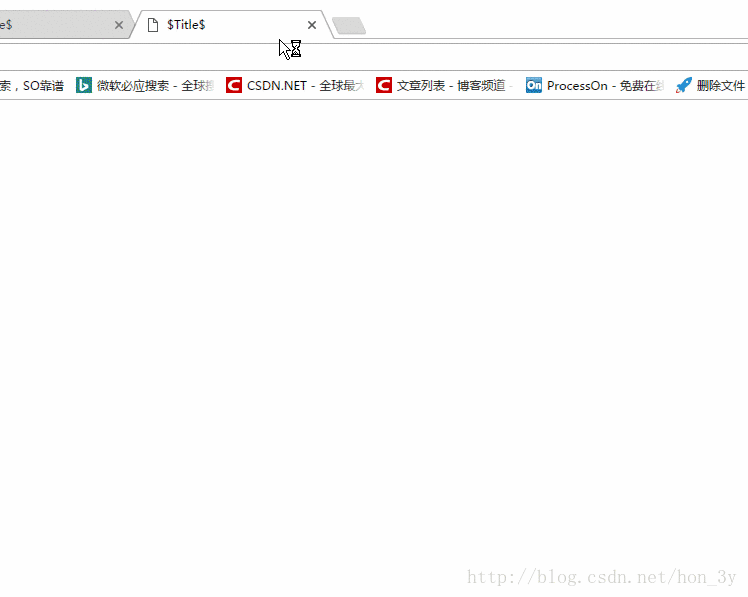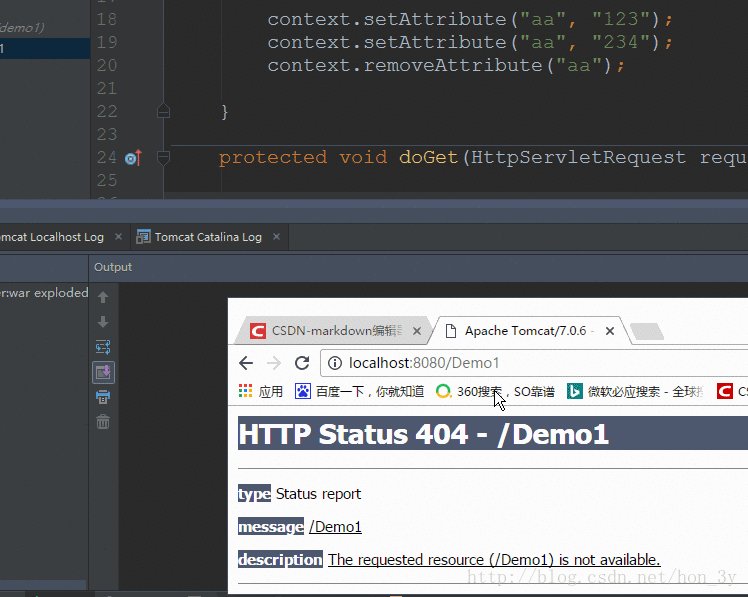自身类作为事件监听器
外部类作为事件监听器
匿名内部类作为事件监听器
内部类作为事件监听器
自身类作为事件监听器:
1 import javax.swing.*;2 import java.awt.*;3 import java.awt.event.*;4
5 /**
6 *Java事件处理机制:自身类作为事件监听器7 *@authorWinty(wintys@gmail.com)8 *@version2008-12-39 */
10 class ThisClassEvent extends JFrame implementsActionListener{11 JButton btn;12
13 publicThisClassEvent(){14 super("Java事件监听机制");15 setLayout(newFlowLayout());16 setDefaultCloseOperation(JFrame.EXIT_ON_CLOSE);17
18 btn=new JButton("点击");19 btn.addActionListener(this);20 getContentPane().add(btn);21
22 setBounds(200,200,300,160);23 setVisible(true);24 }25
26 /**************************************/
27 public voidactionPerformed (ActionEvent e){28 Container c=getContentPane();29 c.setBackground(Color.red);30 }31 /**************************************/
32
33 public static voidmain(String args[]){34 newThisClassEvent();35 }36 }
外部类作为事件监听器:
1 import java.awt.*;2 import java.awt.event.*;3 import javax.swing.*;4
5 /**
6 *Java事件处理机制:外部类作为事件监听器7 *@authorWinty(wintys@gmail.com)8 *@version2008-12-39 */
10 class OuterClassEvent extendsJFrame{11 JButton btn;12
13 publicOuterClassEvent(){14 super("Java事件监听机制");15 setLayout(newFlowLayout());16 setDefaultCloseOperation(JFrame.EXIT_ON_CLOSE);17
18 btn=new JButton("点击");19 btn.addActionListener(new OuterClass(this));20 getContentPane().add(btn);21
22 setBounds(200,200,300,160);23 setVisible(true);24 }25
26 public static voidmain(String args[]){27 newOuterClassEvent();28 }29 }30
31 /*外部类*********************************/
32 class OuterClass implementsActionListener{33 OuterClassEvent oce;34
35 publicOuterClass(OuterClassEvent oce){36 this.oce =oce;37 }38
39 public voidactionPerformed(ActionEvent e){40 Container c=oce.getContentPane();41 c.setBackground(Color.red);42 }43 }
匿名内部类作为事件监听器:
import java.awt.*;import java.awt.event.*;import javax.swing.*;/***Java事件处理机制:匿名内部类作为事件监听器
*@authorWinty(wintys@gmail.com)
*@version2008-12-3*/
class AnonymousEvent extendsJFrame{
JButton btn;publicAnonymousEvent(){super("Java事件监听机制");
setLayout(newFlowLayout());
setDefaultCloseOperation(JFrame.EXIT_ON_CLOSE);
btn=new JButton("点击");/*匿名内部类******************************/btn.addActionListener(newActionListener(){public voidactionPerformed(ActionEvent e){
Container c=getContentPane();
c.setBackground(Color.red);
}
}
);/***************************************/getContentPane().add(btn);
setBounds(200,200,300,160);
setVisible(true);
}public static voidmain(String args[]){newAnonymousEvent();
}
}
内部类作为事件监听器:
import java.awt.*;import java.awt.event.*;import javax.swing.*;/***Java事件处理机制:内部类作为事件监听器
*@authorWinty(wintys@gmail.com)
*@version2008-12-3*/
class InnerClassEvent extendsJFrame{
JButton btn;publicInnerClassEvent(){super("Java事件监听机制");
setLayout(newFlowLayout());
setDefaultCloseOperation(JFrame.EXIT_ON_CLOSE);
btn=new JButton("点击");
btn.addActionListener(newInnerClass());
getContentPane().add(btn);
setBounds(200,200,300,160);
setVisible(true);
}/*内部类*********************************/
class InnerClass implementsActionListener{public voidactionPerformed (ActionEvent e){
Container c=getContentPane();
c.setBackground(Color.red);
}
}/**************************************/
public static voidmain(String args[]){newInnerClassEvent();
}
}
什么是监听器
监听器就是一个实现特定接口的普通java程序,这个程序专门用于监听另一个java对象的方法调用或属性改变,当被监听对象发生上述事件后,监听器某个方法将立即被执行。。
为什么我们要使用监听器?
监听器可以用来检测网站的在线人数,统计网站的访问量等等!
监听器组件
监听器涉及三个组件:事件源,事件对象,事件监听器
当事件源发生某个动作的时候,它会调用事件监听器的方法,并在调用事件监听器方法的时候把事件对象传递进去。
我们在监听器中就可以通过事件对象获取得到事件源,从而对事件源进行操作!

模拟监听器
既然上面已经说了监听器的概念了,监听器涉及三个组件:事件源,事件对象,事件监听器。
我们就写一个对象,被监听器监听
监听器
监听器定义为接口,监听的方法需要事件对象传递进来,从而在监听器上通过事件对象获取得到事件源,对事件源进行修改!
/*** 事件监听器** 监听Person事件源的eat和sleep方法*/
interfacePersonListener{
voiddoEat(Event event);
voiddoSleep(Event event);
}
事件源
事件源是一个Person类,它有eat和sleep()方法。
事件源需要注册监听器(即在事件源上关联监听器对象)
如果触发了eat或sleep()方法的时候,会调用监听器的方法,并将事件对象传递进去
/**** 事件源Person** 事件源要提供方法注册监听器(即在事件源上关联监听器对象)*/
classPerson {
//在成员变量定义一个监听器对象
private PersonListener personListener ;
//在事件源中定义两个方法
publicvoidEat() {
//当事件源调用了Eat方法时,应该触发监听器的方法,调用监听器的方法并把事件对象传递进去
personListener.doEat(new Event(this));
}
publicvoidsleep() {
//当事件源调用了Eat方法时,应该触发监听器的方法,调用监听器的方法并把事件对象传递进去
personListener.doSleep(new Event(this));
}
//注册监听器,该类没有监听器对象啊,那么就传递进来吧。
publicvoidregisterLister(PersonListener personListener) {
this.personListener = personListener;
}
}
事件对象
事件对象封装了事件源。
监听器可以从事件对象上获取得到事件源的对象(信息)
/*** 事件对象Even** 事件对象封装了事件源** 在监听器上能够通过事件对象获取得到事件源***/
classEvent{
private Person person;
publicEvent() {
}
publicEvent(Person person) {
this.person = person;
}
publicPerson getResource() {
return person;
}
}
测试
publicstaticvoidmain(String[] args) {
Person person = new Person();
//注册监听器()
person.registerLister(new PersonListener() {
@Override
publicvoiddoEat(Event event) {
Person person1 = event.getResource();
System.out.println(person1 + "正在吃饭呢!");
}
@Override
publicvoiddoSleep(Event event) {
Person person1 = event.getResource();
System.out.println(person1 + "正在睡觉呢!");
}
});
//当调用eat方法时,触发事件,将事件对象传递给监听器,最后监听器获得事件源,对事件源进行操作
person.Eat();
}

事件源:拥有事件
监听器:监听事件源所拥有的事件(带事件对象参数的)
事件对象:事件对象封装了事件源对象
事件源要与监听器有关系,就得注册监听器【提供方法得到监听器对象】
触发事件源的事件,实际会提交给监听器对象处理,并且把事件对象传递过去给监听器。
Servlet监听器
在Servlet规范中定义了多种类型的监听器,它们用于监听的事件源分别 ServletContext, HttpSession和ServletRequest这三个域对象
和其它事件监听器略有不同的是,servlet监听器的注册不是直接注册在事件源上,而是由WEB容器负责注册,开发人员只需在web.xml文件中使用标签配置好监听器,
监听对象的创建和销毁
HttpSessionListener、ServletContextListener、ServletRequestListener分别监控着Session、Context、Request对象的创建和销毁
HttpSessionListener(可以用来收集在线者信息)
ServletContextListener(可以获取web.xml里面的参数配置)
ServletRequestListener
测试
public classListener1 implementsServletContextListener,
HttpSessionListener, ServletRequestListener {
// Public constructor is required by servlet spec
publicListener1() {
}
publicvoidcontextInitialized(ServletContextEvent sce) {
System.out.println("容器创建了");
}
publicvoidcontextDestroyed(ServletContextEvent sce) {
System.out.println("容器销毁了");
}
publicvoidsessionCreated(HttpSessionEvent se) {
System.out.println("Session创建了");
}
publicvoidsessionDestroyed(HttpSessionEvent se) {
System.out.println("Session销毁了");
}
@Override
publicvoidrequestDestroyed(ServletRequestEvent servletRequestEvent) {
}
@Override
publicvoidrequestInitialized(ServletRequestEvent servletRequestEvent) {
}
}
监听器监听到ServletContext的初始化了,Session的创建和ServletContext的销毁。(服务器停掉,不代表Session就被销毁了。Session的创建是在内存中的,所以没看到Session被销毁了)

监听对象属性变化
ServletContextAttributeListener、HttpSessionAttributeListener、ServletRequestAttributeListener分别监听着Context、Session、Request对象属性的变化
这三个接口中都定义了三个方法来处理被监听对象中的属性的增加,删除和替换的事件,同一个事件在这三个接口中对应的方法名称完全相同,只是接受的参数类型不同。
attributeAdded()
attributeRemoved()
attributeReplaced()
测试
这里我只演示Context对象,其他对象都是以此类推的,就不一一测试了。
实现ServletContextAttributeListener接口。
public classListener1 implementsServletContextAttributeListener {
@Override
publicvoidattributeAdded(ServletContextAttributeEvent servletContextAttributeEvent) {
System.out.println("Context对象增加了属性");
}
@Override
publicvoidattributeRemoved(ServletContextAttributeEvent servletContextAttributeEvent) {
System.out.println("Context对象删除了属性");
}
@Override
publicvoidattributeReplaced(ServletContextAttributeEvent servletContextAttributeEvent) {
System.out.println("Context对象替换了属性");
}
}
测试的Servlet
protectedvoiddoPost(HttpServletRequest request, HttpServletResponse response) throwsServletException, IOException {
ServletContext context = this.getServletContext();
context.setAttribute("aa", "123");
context.setAttribute("aa", "234");
context.removeAttribute("aa");
}

监听Session内的对象
除了上面的6种Listener,还有两种Linstener监听Session内的对象,分别是HttpSessionBindingListener和HttpSessionActivationListener,实现这两个接口并不需要在web.xml文件中注册
实现HttpSessionBindingListener接口,JavaBean 对象可以感知自己被绑定到 Session 中和从 Session 中删除的事件【和HttpSessionAttributeListener的作用是差不多的】
实现HttpSessionActivationListener接口,JavaBean 对象可以感知自己被活化和钝化的事件(当服务器关闭时,会将Session的内容保存在硬盘上【钝化】,当服务器开启时,会将Session的内容在硬盘式重新加载【活化】) 。。
想要测试出Session的硬化和钝化,需要修改Tomcat的配置的。在META-INF下的context.xml文件中添加下面的代码:

测试
监听器和事件源
/** 由于涉及到了将内存的Session钝化到硬盘和用硬盘活化到内存中,所以需要实现Serializable接口** 该监听器是不需要在web.xml文件中配置的。但监听器要在事件源上实现接口* 也就是说,直接用一个类实现HttpSessionBindingListener和HttpSessionActivationListener接口是监听不到Session内对象的变化的。* 因为它们是感知自己在Session中的变化!* */
public classUser implementsHttpSessionBindingListener,HttpSessionActivationListener,Serializable {
private String username ;
publicString getUsername() {
return username;
}
publicvoidsetUsername(String username) {
this.username = username;
}
@Override
publicvoidsessionWillPassivate(HttpSessionEvent httpSessionEvent) {
HttpSession httpSession = httpSessionEvent.getSession();
System.out.println("钝化了");
}
@Override
publicvoidsessionDidActivate(HttpSessionEvent httpSessionEvent) {
HttpSession httpSession = httpSessionEvent.getSession();
System.out.println("活化了");
}
@Override
publicvoidvalueBound(HttpSessionBindingEvent httpSessionBindingEvent) {
System.out.println("绑定了对象");
}
@Override
publicvoidvalueUnbound(HttpSessionBindingEvent httpSessionBindingEvent) {
System.out.println("解除了对象");
}
}
测试代码
User user = new User();
request.getSession().setAttribute("aaa", user);
request.getSession().removeAttribute("aaa");
效果:







![[有奖励]GeneralUpdate开源项目招募开发者](http://pic.xiahunao.cn/[有奖励]GeneralUpdate开源项目招募开发者)









的IP地址)


)